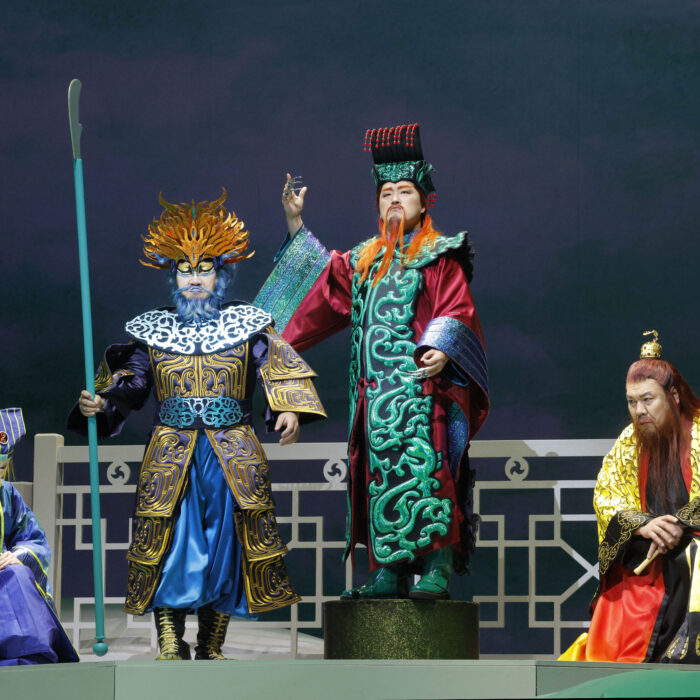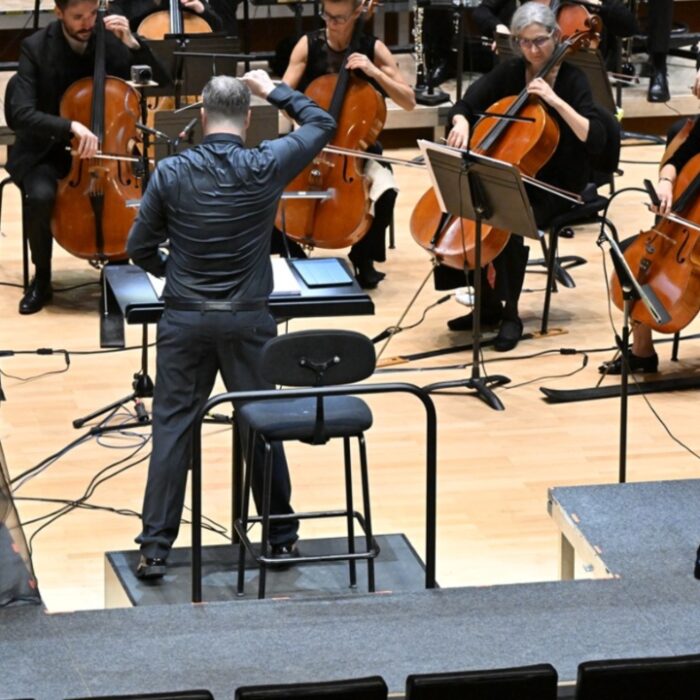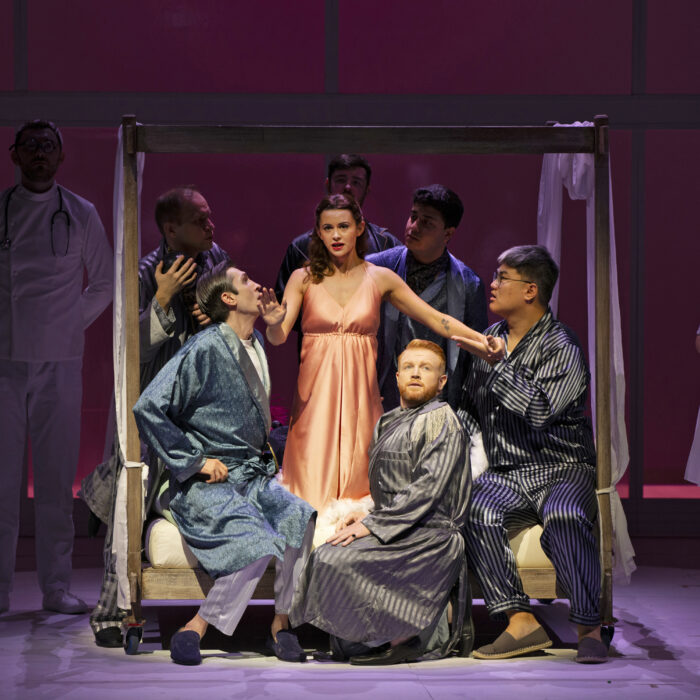
Vino Theater Review 2023: ‘A Ghost’s Endeavor’
Countertenor James M. Brown and friends celebrate the LGBTQ community
By Chris RuelCountertenor James M. Brown brought together a talented group of young artists to perform “A Ghost’s Endeavor,” a recital that included music from the Baroque to today.
The performance was held in the Vino Theater in Brooklyn, New York. The building is a communal area that comprises several levels and a black box theater. From the outside, the nearly block-long building has a warehouse feel. However, inside, artists work in various parts of the expansive structure. There’s nothing new or fancy about it. Small doors—maybe for humans—that dotted the hallways were a curiosity. Take a walk down one corridor, and you’re treated to a rough-looking art exhibit. Art (vocal or otherwise) happens there without pretension. It has a bohemian spirit; Marcello might appear at any moment with his paintbrushes and palette.
Brown, who programmed the evening, believed it was the right time for a recital such as the one presented. It was a success as he sang alongside sopranos Samantha Noonan and Gina Hanzlik, tenor Gabriel Hernandez, and baritone Michael Manganiello. Felix Jarrar was the evening’s collaborative pianist and had the honor of premiering his recent work. The evening’s music featured songs by Benjamin Britten, Geoffrey Burgon, Felix Jarrar, Rosśa Crean, Henry Purcell, Peter Dayton, and Poe Allphin.
The countertenor showed his ability to collaborate effectively, and their performance with colleagues was a strong showing of vocal excellence, technical skill, and emotive interpretation. Brown has good projection; they were as solid singing forte as he was pianissimo, even when diving deep to the bottom or soaring skywards. Their voice quality is vibrant and expressive and sometimes otherworldly in its delicate beauty.
Though the ranks of countertenors are on the rise, the voice type remains a rare treat. Brown filled the venue with an enchanting aura with its otherworldly sound, an apt description given the starry through-line.
Celestial and Earthly Beauty on Display
While we expect singers to perform well in duets and trios, sometimes the chemistry just isn’t there. That wasn’t the case. Brown sang with all the artists, and their ability to mix seamlessly with those of their colleagues was beautiful to hear. They picked the right vocalists with whom to share the stage.
This was clear from the opening work, with Brown singing Britten’s ballad, “Mother Comfort,” in duet soprano Samantha Noonan. Britten was a vigorous advocate of the countertenor voice and holds a special place in Brown’s heart. They discovered the piece when staging other Britten song cycles.
Noonan has an impressive vocal range and technical skill. Her shiny tone twinkled with brilliance; a perfect set-up for Burgon’s “Lunar Beauty.”
Britten inspired Geoffrey Burgon’s cycle with the texts pulled from WH Auden. (On the whole, the evening’s music was filled with literary texts and inspirations.) Though sung with piano, Burgon’s song was originally scored for lute and countertenor.
The English composer gained fame for his television and film scores such as “Tinker, Tailor, Soldier, Spy” and “The Dogs of War.” But he also created an extensive body of work that spanned multiple genres, including orchestral and vocal pieces, such as “Lunar Beauty.” The cycle, though written centuries after Dowland, has a marvelous Baroque sound. While the tessitura is high, Borgun takes countertenors into their lower ranges.
Jarrar’s playing matched the overall quietness of the cycle, except for “Lady, weeping, at the crossroads,” which devolved into delicious musical chaos with a much faster pace and aggressive piano line.
Three Premieres
Next came Jarrar’s “Space Nocturnes” cycle, which included three premieres among the six songs. He, too, used texts from literature. “The Light of Stars” comes from Longfellow; “Address to the Moon” from Hawthorne; and “Monody” from Melville. Jarrar expressed that the songs were written during the dark days of the pandemic in 2020. Not surprisingly, the selections are metaphors for life, death, and hope.
Jarrar added three additional songs, “Dusk in Autumn” (Text by Sarah Teasdale), “Night Fell” (Text by Florence R. Mastin), and “All Hallows Eve” (Text by Lizette Woodworth Reese).
Take a look at the poets again. They’re all women: Teasdale won a Pulitzer Prize for her 1917 poetry collection, “Love Songs;” Reese was named poet laureate of Maryland in 1931 and given an honorary doctorate from Goucher College. Mastin was a graduate of Barnard and taught at Erasmus High School in Brooklyn. Erasmus alumni include Clara Bow (the original “It” girl), Mae West, legendary Bop saxophonist Al Cohn; noir detective novelist Mickey Spillane; and the inimitable Neil Diamond. Mastin died in 1968, and the likelihood that she taught any of the people named above is high.
Poet side note: Teasdale was born in Nyack, NY. She returned there later in life. Mastin hailed from Piermont, NY, a stone’s throw away from Nyack. Two amazing poets came from adjacent (Hudson) River Towns. It’s uncanny.
Brown handled the Bel Canto-esque ornamentation found in “Adress to the Moon” cleanly—nothing muddy about it. “Monody” followed and showed a different side of Jarrar. The tune had a Renaissance sound and the tempo of a dirge.
“The Light of Stars” was fast and put Brown’s lower range to the test, and it was an unexpected abyss coming from the chest.
The piano lines ranged from twinkling to tumbling. Jarrar’s “Space Nocturnes” gave Brown fabulous pieces to sing, and they performed them excellently, from tender pianissimos to the wild jumps.
Jumping Back and Jumping Forward
After a brief intermission that included wine, cheese, and crudités, Part II kicked off with Purcell’s “Lost is my Quiet.” The text was written anonymously. Gina Hanzlik navigated the Baroque tune with diamond clarity and with a voice that’s knife’s edge sharp, while Brown added a darker element to the duet. Hanzlik’s bright tone was confident and secure, with a natural ease. Both vocalists did an outstanding job with the piece’s dynamics.
One of the highlights of the evening was the performance of “The Need of Comrades,” by Peter Dayton, who adapted Walt Whitman’s “Calamus.” The piece was a stunning showcase of a trio of vocal talent: Brown, tenor Gabriel Hernández, and baritone Michael Manganiello appeared together. In his program notes, Brown included Dayton’s thoughts, which are excerpted by this reviewer.
“Whitman’s poem “Calamus” is a poignant intersection of the poet’s celebration of human affection (pointedly homoerotic affection) and his political concerns as a American citizen before, during, and after the civil war… imagery of men passionately embracing, kissing, pining for each other is impossible to construe in this day and age as anything other than homosexually inclined. “…Calamus, turns the “need of comrades” from a sexual question into a socio-political question. At a time of political instability previously unprecedented in America’s history, “Calamus” is a cry for unity: the unification of hearts and minds. “…the clock has turned forward on the acceptance of LGBT individuals and non-heteronormative love. However, writing in a time of, yet again, staggering political disunity, as well as a resurgence of conservative ideology, I hope that “The Need of Comrades” portrays something of a vision of a society founded upon love and affection.”
Here’s what was heard over the course of the eight songs comprising the cycle: Manganiello shook the floor with their powerful low notes, but they also have strength and security up top. Could they be a baritenor? That’s the issue with fachs. Manganiello defies them. They may be placed in the baritone bin, but they’re far more. Exciting is an apt description of this talented vocalist.
Meanwhile, Hernández’s instrument was marked by a sense of warmth and balance. Their brassy and colorful vocal tone conveyed emotional richness and depth with rounded and balanced delivery. This reviewer has heard them before; they’re a tenor to watch as they grow in their career, for sure.
The last piece listed on the program was a testament to the power of self-expression. Poe Allphin’s piece resonated against the backdrop of the culture wars. Brown in their program notes related how the piece struck them: “[Allphin has] combined some incredibly vivid text that speaks to the, sometimes dysmorphic, commentary we have as trans Individuals. Their text painting of poetry from Morgan Ureña grabbed me by the heart and gave me a visceral and emotional reaction.”
What follows is a beautiful example. “My reflection rattles in the glass cracks/like my spine in the morning./My naked form is spliced, quadrupled, and from the mirror, euphoria erupts.”
Such powerful words closed the recital. Kind of. There was one last number, the Epilogue from Stravinky’s “The Rakes Progress.” This was performed tutti. Five brilliant voices came together in a vaudeville, revealing the moral of the opera’s story, but also that of the evening. We, the audience, united with those on stage in celebration of Brown’s “community and Queer kin.”


